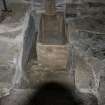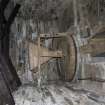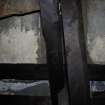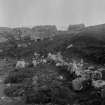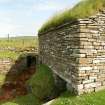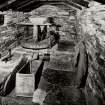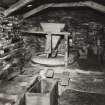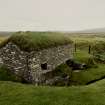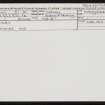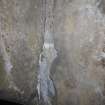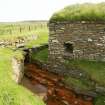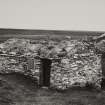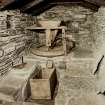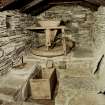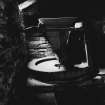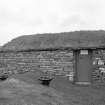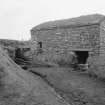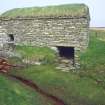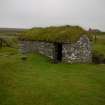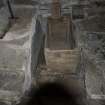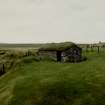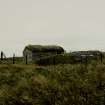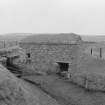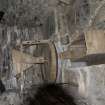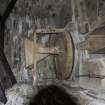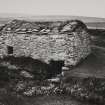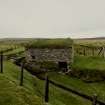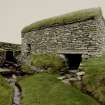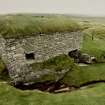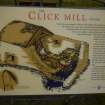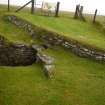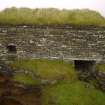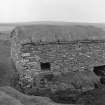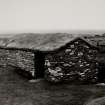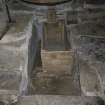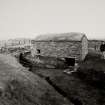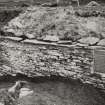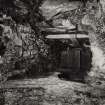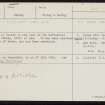Dounby, Click Mill
Horizontal Mill (19th Century)
Site Name Dounby, Click Mill
Classification Horizontal Mill (19th Century)
Alternative Name(s) Milbrig, Hillside, Birsay; Dounby, Norse Mill; Dounby Mill
Canmore ID 2269
Site Number HY32SW 5
NGR HY 32540 22848
Datum OSGB36 - NGR
Permalink http://canmore.org.uk/site/2269
- Council Orkney Islands
- Parish Birsay And Harray
- Former Region Orkney Islands Area
- Former District Orkney
- Former County Orkney
HY32SW 5 32538 22849
The Click Mill at Dounby is the last of the horizontal water-mills of Orkney, still in use. It has been restored by the Ministry of Works, and has been scheduled.
S Cruden 1949.
The Click Mill, as described, is at HY 3253 2285.
Under Guardianship.
Visited by OS (RL), 27 May 1967.
(Location cited as HY 325 228). Click Mill, Dounby, built c. 1825. A small roughly rectangular dry flagstone rubble bulding, with a flagstone roof covered in turf. The tirl has two rows, each of six paddles. The stones have a wooden casing and a chute leading to a meal box. The hopper is supported on a wooden gantry. Now a Guardianship ancient monument.
J R Hume 1977.
The mill at Millbrig, Birsay (NE of Dounby) was built in about 1822-4 by John Spence, replacing an older mill which had become ruinous. Because of its uniqueness in Orkney, it was repaired by the Orkney Archaeological Society and offered to the (then) Office of Works in 1932, since when it has been a Guardianship Monument.
A Fenton 1978.
Publication Account (1996)
This mill is the only surviving example of a horizontal watermill in Orkney, and it has been excell en tly restored with a ll its machinery in working order and its flagstone roof intact. It was built around 1823 to replace an older mill in the same place, Millbrig, and it was used throughout most of the rest of that century; it has been necessary to engineer a piped supply of water so that the restored mill can operate for about 8 minutes at a time, because the original water supply was destroyed by quarrying in the burn for stones for road-making in the 1920s.
The building is very small , only abour 4.5m by 2m, with the entrance in one of the long walls with a small opening or winnowing hole in the opposite wall to create a through draught. There is another unusual feature in the tirl, which has two rows of blades, one set above the other making a total of 12 blades. The mill was said to grind about a bushel of grain per hour (about 250 kilograms).
Information from ‘Exploring Scotland’s Heritage: Orkney’, (1996).
Photographic Record (28 July 2010)
Dounby click or horizontal mill is a Guardianship Monument maintained by Historic Scotland. It was photographed in 2010 as part of the upgrade of industrial and argicultural sites on Mainland Orkney for the RCAHMS database.
Information from RCAHMS (MMD) 15 September 2010.
Field Visit (14 July 2015)
HY 32540 22849 Circa 1825 small oblong mill, according to the listing notes it is the ‘last surviving working example in Orkney of a primitive type of mill more numerously represented in Shetland and Faroes’. The building has a flagstone roof covered with turf, a traditional roofing technique in Orkney, which is thatched continuously across the ridge. The thatch has been left uncovered. The mill, which is in working condition, is open to the public and is in the guardianship of Historic Environment Scotland.
Visited by Zoe Herbert (SPAB) 14 July 2015, survey no.147
Orkney Smr Note
This mill is the only surviving example of a horizontal water
mill in Orkney, and it has been excellently restored with all its
machinery in working order and its flagstone roof intact. It was
built around 1823 to replace an older mill in the same place
Millbrig, and it was used throughout most of the rest of that
century; it has been necessary to engineer a piped supply of water
so that the restored mill can operate for about 8 minutes at a
time, because the original water supply was destroyed by quarrying
in the burn for stones for road making in the 1920's.
The building is very small, only about 4.5m by 2m, with the
entrance in one of the long walls with a small opening or
winnowing hole in the opposite wall to create a through draft.
There is another unusual feature in the tirl, which has two rows
of blades, one set above the other making a total of twelve
blades. The mill was said to grind about a bushel of grain per
hour (about 250 kilograms). [R1]
Information from Orkney SMR [n.d.]

























































